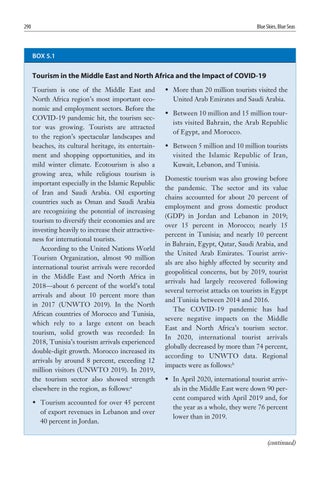290
Blue Skies, Blue Seas
BOX 5.1
Tourism in the Middle East and North Africa and the Impact of COVID-19 Tourism is one of the Middle East and North Africa region’s most important economic and employment sectors. Before the COVID-19 pandemic hit, the tourism sector was growing. Tourists are attracted to the region’s spectacular landscapes and beaches, its cultural heritage, its entertainment and shopping opportunities, and its mild winter climate. Ecotourism is also a growing area, while religious tourism is important especially in the Islamic Republic of Iran and Saudi Arabia. Oil exporting countries such as Oman and Saudi Arabia are recognizing the potential of increasing tourism to diversify their economies and are investing heavily to increase their attractiveness for international tourists. According to the United Nations World Tourism Organization, almost 90 million international tourist arrivals were recorded in the Middle East and North Africa in 2018—about 6 percent of the world’s total arrivals and about 10 percent more than in 2017 (UNWTO 2019). In the North African countries of Morocco and Tunisia, which rely to a large extent on beach tourism, solid growth was recorded: In 2018, Tunisia’s tourism arrivals experienced double-digit growth. Morocco increased its arrivals by around 8 percent, exceeding 12 million visitors (UNWTO 2019). In 2019, the tourism sector also showed strength elsewhere in the region, as follows:a • Tourism accounted for over 45 percent of export revenues in Lebanon and over 40 percent in Jordan.
• More than 20 million tourists visited the United Arab Emirates and Saudi Arabia. • Between 10 million and 15 million tourists visited Bahrain, the Arab Republic of Egypt, and Morocco. • Between 5 million and 10 million tourists visited the Islamic Republic of Iran, Kuwait, Lebanon, and Tunisia. Domestic tourism was also growing before the pandemic. The sector and its value chains accounted for about 20 percent of employment and gross domestic product (GDP) in Jordan and Lebanon in 2019; over 15 percent in Morocco; nearly 15 percent in Tunisia; and nearly 10 percent in Bahrain, Egypt, Qatar, Saudi Arabia, and the United Arab Emirates. Tourist arrivals are also highly affected by security and geopolitical concerns, but by 2019, tourist arrivals had largely recovered following several terrorist attacks on tourists in Egypt and Tunisia between 2014 and 2016. The COVID-19 pandemic has had severe negative impacts on the Middle East and North Africa’s tourism sector. In 2020, international tourist arrivals globally decreased by more than 74 percent, according to UNWTO data. Regional impacts were as follows:b • In April 2020, international tourist arrivals in the Middle East were down 90 percent compared with April 2019 and, for the year as a whole, they were 76 percent lower than in 2019.
(continued)






